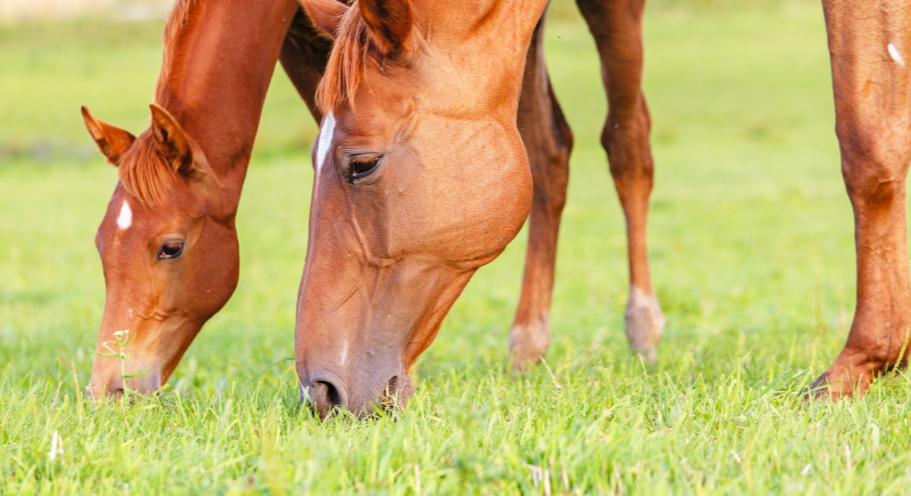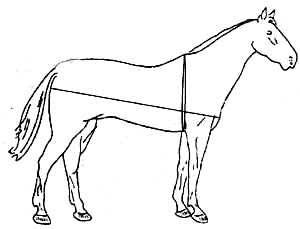Breeding mares

Every horse has a different need in calories for its basic maintenance. With basic maintenance we imply what is necessary to maintain essential body functions such as digestion, food intake, standing and moving. These depend on the race of the horse, the sexe and its temperament. Stallions usually have 10-20 % higher maintenance needs compared to mares or geldings.
Maintenance needs according to body weight of the horse.
Bodyweight (kg) VEP VRE
100 kg 1230 95
200 kg 2070 160
300 kg 2810 215
400 kg 3490 270
500 kg 4120 320
600 kg 4730 360
700 kg 5300 400
800 kg 5870 450
In order to assess the nutritional needs of the horse correctly, the owner needs to calculate the body weight as accurately as possible. The most common formulas to do so require the height (H) and the chest circumference (CC) of the horse.
Breeding mares: weight = 5,2 x CC + 2,6 x H – 855 (+- 25 kg)
Young horses: weight = 4,5 x CC– 370 (+- 23 kg)
Riding horses: weight = 4,3 x CC + 3,0 x H – 785 (+- 26 kg)
Heavy horses: weight = 7,0 x CC – 800 (+- 27 kg)
Example: a riding horse, mare, 7 years old, with a chest circumference of 180 cm and a height of 168 cm :
weight= 4,3 x 180 + 3,0 x 168 – 785 = 493 kg

There is another, easier way of estimating the body weight;
weight (in kg) = (CC in cm)² x (body length in cm) 11,900
The length is measured from the chest bone to the buttock
Eg: CC 168 cm – length 212 cm
(168)² x 212 / 11,9 = 502 kg (approx)
Pregnancy bonus
In the last 4 months of the pregnancy the mare needs additional and adequate concentrate. A large part of the energy the mare absorbs via the food is passed on to the foal during this stage of the pregnancy. The amount of extra concentrate needed is explained in the graph, and depends on the weight of the mare.
8 mnth pregant 9 mnth pregant 10 mnth pregant 11 mnth pregant
100 kg 50 105 140 200
200 kg 105 210 285 405
300 kg 155 310 425 605
400 kg 210 415 570 805
500 kg 260 520 710 1005
600 kg 315 625 855 1210
700 kg 365 725 995 1410
800 kg 420 830 1140 1610
Lactation bonus
This graph shows the additional concentrate a lactating mare needs according to her weight and the age of the foal. A major part of a mares enery intake goes straight to the foal, so this has to be countered by adjusted feeding.
1st month 2d+3rd month 4th+5th month
100 kg 960 970 790
200 kg 1920 1940 1580
300 kg 2400 2500 1980
400 kg 3200 3320 2640
500 kg 4000 4170 3300
600 kg 4800 5000 3960
700 kg 5600 5830 4620
800 kg 6400 6660 5280
This bonus is needed because the mare produces more milk in the first couple of months, but milk production decreases later on. On average a lactating mare produces 12,5 kg of milk per day in the first mont, around 15kg in the second and third month, and 12,5 kg again in the 4th and 5th month. The composition also differs over the months.
Graph: Need in VEP and VRE per animal per day
Weight Maintenance Pregnant mare Lactating mare
Month 9 Month 10 Month 11 Month 2/3 Month 4/5
VEP VRE VEP VRE VEP VRE VEP VRE VEP VRE VEP VRE
200 2070 160 210 50 285 65 405 100 1940 310 1580 240
300 2810 215 310 75 425 100 605 150 2500 395 1980 300
400 3490 270 415 100 570 130 805 200 3320 530 2640 400
500 4120 315 520 125 710 165 1005 250 4170 660 3300 500
600 4730 365 625 155 855 195 1210 300 5000 790 3960 600
700 5310 410 725 180 995 230 1410 350 5830 925 4620 700
800 5870 450 830 205 1140 260 1610 400 6660 1055 5280 800
Ration estimation: example
a breeding mare lactating in her third month, bodyweight is 570 kg
Need: VEP maintenance: 4120 + (4730-4120) x 0,7 = 4547
Lactating bonus: 4170 + (5000-4170) x 0,7 = 4751
Total = 9298 VEP VRE maintenance: 320 + (360 – 320) x 0,7 = 348
Lactating bonus: 660 + (790 – 660) x 0,7 = 751
Total = 1099 VRE
Ration: grass (130 VEP; 24 VRE) and Lannoo Breeding (850 VEP; 95 VRE)
33 kg grass: 4290 VEP; 792 VRE
6 kg concentrate : 5100 VEP; 570 VRE
Total: 9390 VEP; 1362 VRE
Total amount of kg DS a horse can process per day 2,2 x bodyweight/ 100 = 12,5 kg
33 kg grass x 16 % DS = 5,28 kg
6 kg concentrate x 88 % DS = 5, 28 kg Total = 10,56 kg
Conclusion: A breeding mare goes through 3 stadia per year (normal, end of pregnancy and lactating).
From the weaning of the foal until 3-4 months before the birth of the next one, only the basic maintenance needs have to be met. This depends on the body weight of the mare. To cover these needs a daily doses of roughage and Lannoo Basic or Active should be sufficient. The difference between those two mixtures are as follows; Lannoo Active more energy and vitamins than Lannoo Basic, in order to cover the nutritional needs of the horse with less kg of concentrate.
In the last couple of months of pregnancy (4 months on average) the mares starts using a lot of energy to develop the foetus, and some more to get the milk production going. It 's obvious that this energy needs to be compensated by more protein and energy in the forage. Calcium, first-rate proteins, phosphor and vitamin A and D3 are the most indispensable elements in the diet of a pregnant mare in her last months. Another vital element in the mares health at this stage is a visit by the dentist. The teeth need to be in optima forma to process such high quantities of feed in the most adequate way. Deworming and vaccinating is equally important, as the antibodies the mare produces will be passed on through the colostrum and protect the foal against diseases in its early life. It's also preferable to keep the mare in the same place during the last month of pregnancy, as the antibodies are specific to the environment the mare and foal live in.
In order to ensure that your mare ingests enough nutrients, vitamins and minerals it is advised to complement the daily ratio of roughage with Lannoo Breeding.
Right after birth, one of the first preoccupations should be the good discharge of the placenta. Any piece of placenta that is left behind in the womb could entail laminitis. A major part of the lactating mares energy goes to the production of milk. The most important task the concentrate should fulfill is to replenish the minerals, vitamins and proteins the mare gives away to her foal. A key factor in this problem is the quality of the protein in the feed and sufficient dosage of calcium, phosphor and vitamins A and D3. The composition and the quality of the mother milk depend largely on the feed the mare ingests. In order to ensure milk of good quality, sufficient concentrate is a key element of the diet. On top of that, 4 kg of hay are a minimum. Usually, at this stage the mare will also be covered again. A certain surplus of B-carotene and vitamin A can benefit the fertility. The same goes for the condition of the mare: she should be in good physical health, but one should avoid an overly fat mare, as it decreases fertility. All these factors are taken into account in Lannoo Breeding concentrate, which makes it the ideal mix for a breeding mare in that time of the year.
